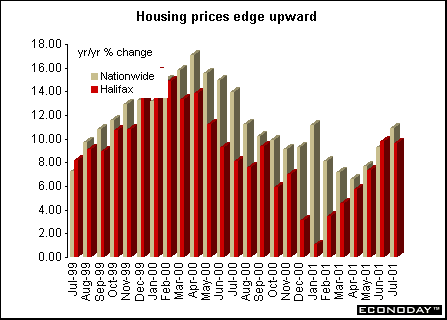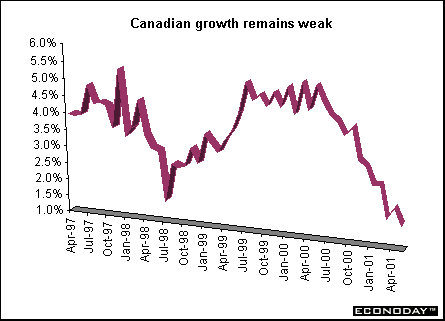
Indicator scoreboard
EMU - July seasonally adjusted Reuters purchasing managers index slid to 47.3 from 47.9 in June. The index declined for the 14th consecutive month. An index level above 50 indicates the manufacturing sector is expanding, while a level below 50 indicates contraction. The further the index falls below 50, the greater the pace of contraction. The input prices index, which is not part of the overall PMI, decelerated sharply to 46.0 from 51.1 in June due largely to lower energy prices. The index is based on results from Germany, France, Italy, Spain, Ireland, Austria, the Netherlands and Greece.

July seasonally adjusted Reuters PMI services activity rose to 53.2 from 52.9 reported in June. The rise was due almost entirely to an improvement in the French economy. All sub-indexes fell except employment. The Reuters composite index for manufacturing and services output - combining data from the services survey and the purchasing managers' index - fell to 51.0 from 51.3 in June.
July European Commission's economic sentiment index fell to 100.6, down from 101.2 in June. This was the seventh month in a row that all four elements of the index declined. Industrial confidence fell to minus 9 in July from minus 7 in June. The July decline largely reflected deterioration in new orders and export order outlooks. Consumer confidence fell to a reading of minus 7 from minus 5 in June. The decline was due largely to the present state of the economy as well as the future outlook and concern on unemployment. Construction confidence and the share price index fell for the second straight month. Industrial confidence and consumer confidence each account for one-third of the weighting in the total economic sentiment index. Share prices and construction industry sentiment each count for one-sixth.

June seasonally adjusted unemployment rate remained unchanged at 8.3 percent. Of the nine EMU states reporting data, unemployment fell in two in June, rose in two and remained unchanged in five.

May real seasonally and workday adjusted retail sales 0.1 percent but rose 0.5 percent when compared with last year. The May decline was influenced by the sharp rise in consumer prices during the month, spurred by higher energy prices. Household goods led sales declines, down 0.6 percent, followed by food, drink and tobacco sales, down 0.4 percent. Clothing and footwear sales, however, rose 0.7 percent.

June industrial producer prices (excluding the construction sector) were flat on the month but rose by 3.3 percent on the year. Energy prices declined 0.1 percent after hefty increases in April and May. Intermediate prices excluding energy slipped 0.1 percent, but rose 1.5 percent when compared with last year. Durable consumer goods rose 0.1 percent, while non-durable consumer goods prices were flat. Capital goods posted a slight increase of 0.1 percent and 1.1 percent on the year.

First quarter revised real gross domestic product increased 0.5 percent, down from the 0.6 percent growth that was previously reported. On the year, GDP was revised down from 2.6 percent to 2.5 percent. Details of the downward revision were not immediately available.
Germany - June pan-German real plant and equipment orders were down 9 percent when compared to last year, according to the German machinery manufacturers' association (VDMA). Foreign orders fell 9 percent on the year while domestic orders fell 10 percent. In the second quarter of 2001, total orders were down 4 percent on the year, with domestic orders off by 6 percent and foreign demand down 2 percent.
France - June seasonally adjusted unemployment rate rose to 8.8 percent from 8.7 percent in May. This was the first increase in three years. The number of unemployed pushed higher for the second straight month with a rise 31,000 to 2.339 million.

June producer price index fell 0.1 percent but was up 2.3 percent when compared with last year. Excluding food and energy, the PPI was unchanged on the month and up 1.7 percent on the year. Falling energy combined with semi-finished goods prices to bring about the decline. Industry energy prices fell 0.4 percent on the month but were up 1.8 percent on the year.
Italy - June producer price index fell 0.2 percent but rose 2.3 percent when compared with last year. Prices fell mainly due to lower natural gas prices. The PPI excluding energy prices was unchanged on the month and up 1.6 percent on the year. Intermediate goods shed 0.4 percent on the month but rose 4 percent on the year. Consumer goods edged up 0.1 percent on the month and 2.6 percent on the year, while investment goods were unchanged on the month and up 1.2 percent on the year.
Britain - July seasonally adjusted nationwide building society house price index rose 1.1 percent following a 1.9 percent increase last month. The annual rate pushed up to 10.9 percent from 9.3 percent in June.

July seasonally adjusted Halifax house price index rose 0.7 percent compared with a 1.6 percent gain in June. The annual rate of growth was little changed at 9.6 percent in July from 9.7 percent in June. The increase was the seventh straight month house prices have gone up.
Asia
Japan - June industrial production fell 0.7 percent, the fourth monthly decline. Production fell 4 percent in the second quarter and 3.7 percent in the first quarter. Personal computer and cosmetics makers led the decline in factory production. Electrical machinery production fell 3.7 percent, the biggest drag on overall production. Production of chip making machines and plastics fell 8.7 percent from a year earlier.
June seasonally adjusted spending by salaried workers fell 3 percent. Second quarter spending fell 3.3 percent indicating that consumer demand probably dragged on economic growth last quarter. People spent less on cars, home repairs and education. Spending on refrigerators and air conditioners also fell. Consumers increased spending on clothing, utilities and medical supplies. Seasonally adjusted income fell 1.9 percent, the second monthly decline. Incomes climbed 1.1 percent in the quarter, buoyed by a 4.3 percent increase in April. The propensity to spend ratio, which falls when people save more, fell to 68.9 percent from 70.6 percent. For the whole second quarter, it fell to 69.5 percent, the lowest in a quarter century.
June unemployment rate remained at 4.9 percent, which matches a record high. Construction companies shed 170,000 jobs and manufacturers cut 30,000 jobs. Hiring at communications companies and an increase in agricultural jobs partly offset those declines. There were 61 jobs available for every 100 applications at state run job centers in June, unchanged from May.

Americas
Canada - May real gross domestic product at factor cost grew by 0.3 percent, the strongest showing in seven months, led by unusual changes in educational and government services. Manufacturing showed its strongest gain in 12 months, up 0.9 percent, on higher production for automobiles and electronic equipment. Overall, 14 of 22 major industry groups, which account for 81.8 percent of manufacturing output, increased production.



Introduction • Global
Stock Market Indexes • Recap of Global Markets
• Currencies • Indicator
Scoreboard

The Bottom Line •
Looking Ahead
|